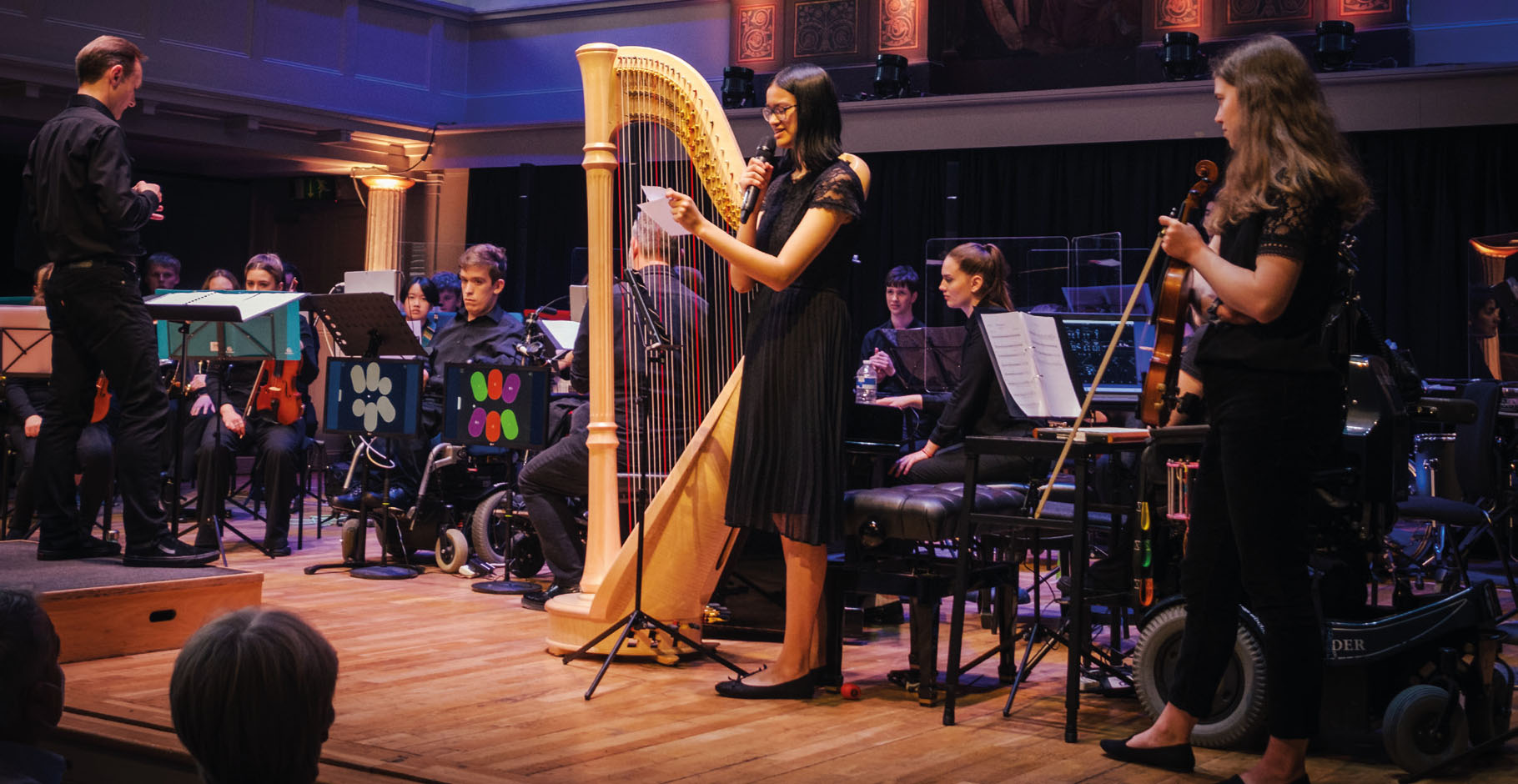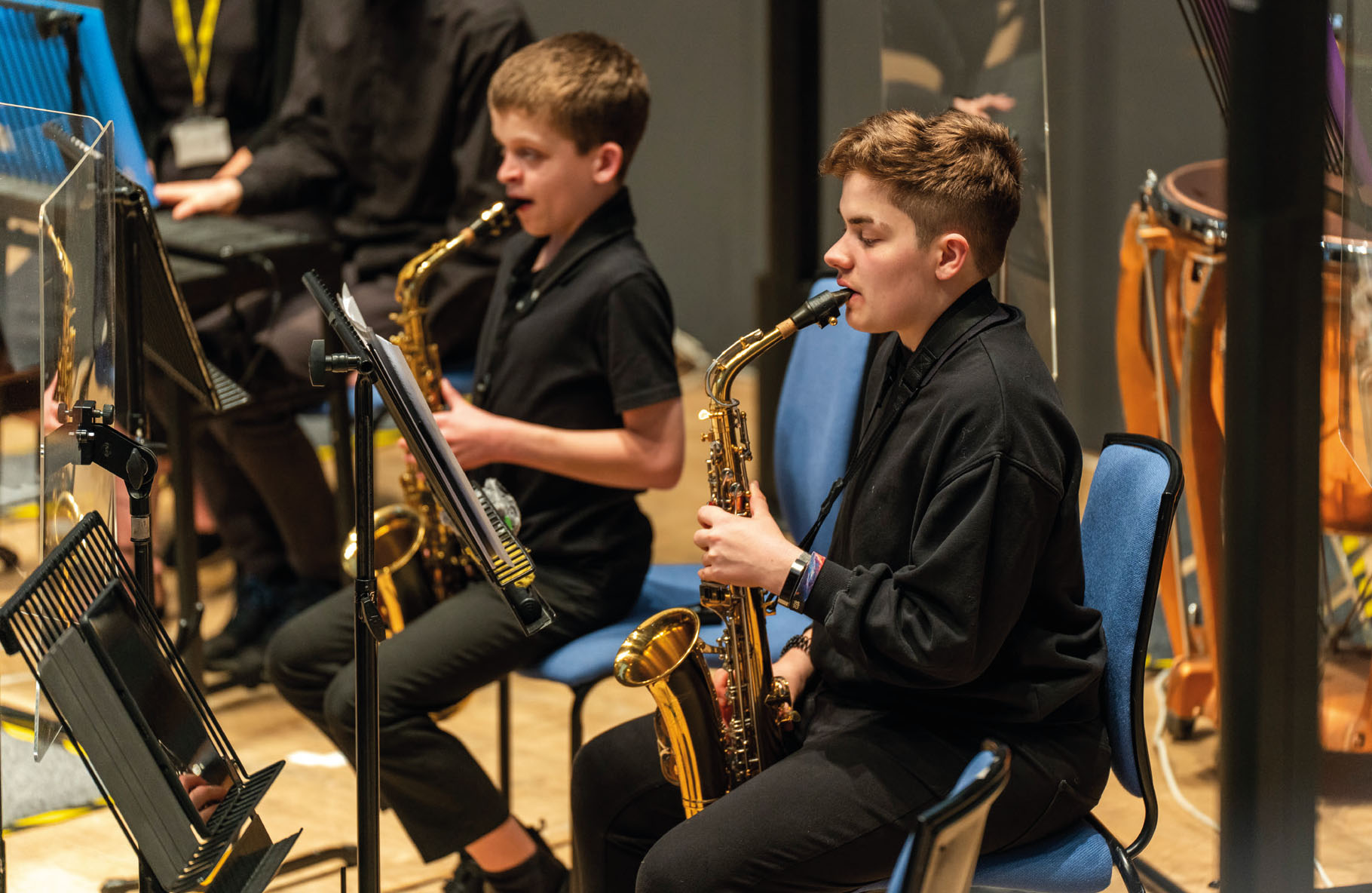
It's a grey and rainy Sunday, but inside a packed St George's Bristol, a world of colour and possibility awaits. We're not here for a ‘standard’ orchestra – I spot that as well as a harp, there's an electric guitar and drum kit, and as well as marimba and timps there's an accordion and lots of electronics. The audience too is set up a bit differently, with relaxed beanbag areas, and lots of space for concertgoers using wheelchairs. A British Sign Language (BSL) interpreter is on stage. This is the second ever concert for the National Open Youth Orchestra (NOYO), an inclusive disabled-led ensemble for talented young musicians.
A solo pianist begins with the familiar chords of Over the Rainbow before shimmering strings and electronic instruments join in. The winds enter and there's a fugue-like feeling before the French horn introduces a new melody. The texture grows and the tempo picks up as the ensemble slides into a groovy, dramatic descending riff, before dropping to finish as it started with lone piano. Sleeping Rainbows – a mashup of Harold Arlen's Over the Rainbow and The Sleeping Tune by Gordon Duncan is a hit with the audience.
Harpist Holli Pandit takes the mic to introduce the next piece, Day One by Liam Taylor-West. NOYO's democratic commission process is led by the young musicians; composers send in ‘sketches’ which the players try out and vote on, with the winners being funded to create full pieces. ‘Lots of the music we play, you wouldn't really get in a stereotypical classical music concert,’ Pandit says afterwards. ‘We believe that it's best if disabled and non-disabled musicians can integrate, and then we can come up with fresh ideas and be more creative, exploring different parts of music.’

Harpist Holli Pandit introducing the programme at St George's Bristol © EVAN DAWSON
Carefully selected electronic instruments
NOYO has commissioned Taylor-West twice, and it's clear that the musicians love playing his music. In three short movements, we hear Sigur Rós-like moments, minimalist phase sections, and slow, soft and expressive 7/8. I'm struck by how tight the ensemble is throughout all these changes.
There are several regional NOYO centres, and each piece in the concert is commissioned and led by a different regional group. London music leader Beatrice Hubble explains more about the process of blending the acoustic and electronic sounds: ‘What's really important to us is that the amplification of the electronic instruments is only to the level of an instrument, because we are not an amplified ensemble’.
Alongside acoustic instruments, NOYO features the Clarion, the LinnStrument, and the Seaboard RISE. A lot of thought has gone into selecting the electronic instruments. There are thousands out there, but NOYO rejects any that would limit their inclusive approach – nothing that would need a technician to set up, nothing without scope for progression. Like their peers on acoustic instruments, the young musicians play the electronic instruments live, expressively and independently.
The Clarion is designed to work with assistive technology that young people already use and can be played with any part of the body – the head, the feet or even the eyes. ‘It's so flexible’, Hubble explains. ‘It can do bassline; it can do melody; it can do harmony.’ Just as we would see a harpist or a French horn player playing their instrument, the concert audience can see the Clarion screen and what the musician is doing. ‘It was hard to learn music, but now my timing is probably perfect,’ says Clarion player Leo Manh Carstensen. ‘I like the group and felt terrific at all the performances.’
Seaboard RISE players use an incredibly flexible and intuitive keyboard interface – instead of lever keys it has a responsive rubber surface. The LinnStrument is another sensitive interface, with pitches arranged as on a string instrument rather than a piano keyboard. LinnStrument player Sally Kidson has a big role in the next piece, Samuel Coleridge-Taylor's Variations on African Air – her interplay with flautist Rhian Davies showcases NOYO's beautifully worked out acoustic-electronic blend.
‘We've got to think about people's ears as well,’ Hubble says. ‘It's lovely to have our big bass synth playing out but that continuous sound can be a lot – we need to be sure that our electronic instruments don't take over, but also that they are really heard. The work that Sally does on the LinnStrument is so fine – it's melody and we need to hear it.’

Jamie Moody on stage with NOYO at Birmingham Town Hall © JONATHAN WILLIAMS
An active participant
Composer and harmonica/synth player Oliver Cross has been with NOYO from its beginnings. Introducing his piece Barriers to the audience, he speaks movingly of the disabled musicians, composers and artists we have lost in the pandemic.
Cross makes full use of the resources at his disposal, beginning with an insistent, rhythmic melody on the harp. Marimba, accordion, and bass synth join and fill out the sound, with pitch bends from the synth adding edge. The snare drum keeps a lively pulse until the music comes to an abrupt stop. Glassy sighing electronics and strings begin a slower section, with the finale featuring a driving bass line and triumphant trumpets. Despite the serious subject matter, there's a sense of optimism to the music and the musicians clearly love playing it.
The young musicians also worked closely with composer Alexander Campkin on What Fear We Then? a whole-NOYO piece exploring the journey from non-disability to disability. ‘It's been amazing playing a piece that has only been composed in the past few years,’ says saxophonist Jamie Moody, ‘and having a living composer who could talk to us about his feelings behind the piece and not only give feedback, but also listen to our suggestions.’
‘I think one of the most rewarding aspects of NOYO is feeling like an active participant in the things that we play. All too often in a lot of other music groups, you tend to play from the same repertoire of classical and romantic and baroque pieces, and the interpretations and expressions of that music will either be based on how every other orchestra has played these pieces, or how the conductor thinks it should be played,’ they add.
High standards built in
What Fear We Then? is a kaleidoscopic ride through sound, colour and shape, utilising every part of NOYO's rich, cinematic palette. The tempo never drops as the minimalist opening gradually builds; there are drum rolls, cheeky cuckoo woodwinds, and virtuoso accordion passages. It's a satisfying and always surprising experience – a little boy in the audience gets to his feet to dance. NOYO are as focused and tight as any seasoned ensemble, and it's hard to believe they have only ever performed together once before.
I ask Hubble how NOYO reached their standard of professionalism in just a few years. She explains that high standards are built in. ‘We need to be there on time, we need to be ready to start on time – we don't make those sorts of allowances. We try to keep everything really, really professional, and often that's quite a new space for those young people to be in.’
Hubble stresses that inclusion means a lot of hard work behind the scenes from the pastoral team. NOYO sends out extremely detailed schedules for rehearsal and concerts, including photos of the spaces, so that the young musicians know exactly what will happen. Music (standard notation, visual scores, or recordings) is sent out well in advance, and music leaders let everyone know beforehand when they will be asking for input in rehearsal so that the musicians can prepare and give their best contribution.
‘There's a lot of anxiety sometimes with the expectation from families that we're going to get it wrong – because it's been got wrong so many times before – and that we're not going to hear them,’ she says. ‘I remember that feeling before our first rehearsal where I didn't know what was going to happen. We knew what instruments the young people played, but we didn't know what they'd all be like in a room together. We didn't know what our music would be like either. I remember being absolutely excited, but also feeling a huge sense of the unknown.’
After a playful deconstructed Spring from Vivaldi's Four Seasons, and Hans Zimmer's epic Time, the concert finishes to a standing ovation. ‘Our debut concert was one of my proudest moments,’ says French horn player Georgina Spray. ‘I have mixed feelings now that we've played all of our concerts this year. I'm sad that the orchestra is never going to be like this again, as before September, some members will leave and more will join NOYO. But I'm super excited about where NOYO could go! The possibilities are endless with the music we play, the instruments in the orchestra, and where we perform.’








